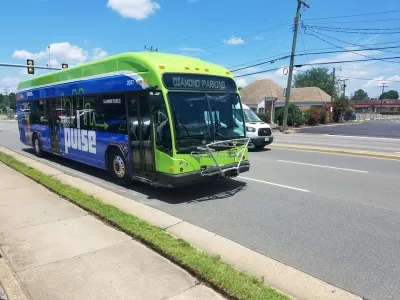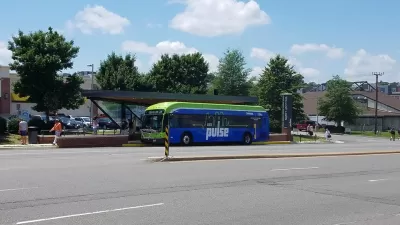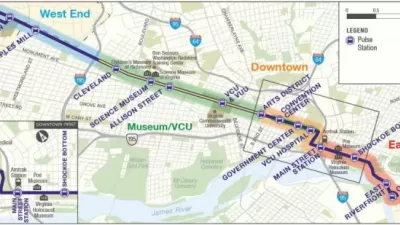The three-year program will expand transit to rural and suburban areas that currently lack access to the region’s fixed-route bus lines.

A three-year microtransit pilot program run by the Greater Richmond Transit Company (GRTC) is coming to six localities in the greater Richmond, Virginia area, reports Wyatt Gordon in Greater Greater Washington.
The program aims to “close mobility gaps in rural and suburban parts of the region via an on-demand system that will allow people to book rides in real time and get picked up and dropped off in designated areas.”
The need is real: “Of the 2,165 square miles which comprise the Greater Richmond region, GRTC’s fixed-route bus service currently only covers 9% of that area, leaving the vast majority of Central Virginia’s more than one million residents with no other options to get around besides owning a private vehicle,” Gordon explains.
The pilot will also give officials insight into transit demand in previously underserved areas. “Such service is an easy way to test demand in areas whose demographics and land use patterns are conducive to transit but don’t yet enjoy any public transportation.”
Details about the type of vehicles to be used in the fleet, fares, and other program elements are yet to be decided. The program is funded in part by a grant from the Department of Rail and Public Transportation’s Transit Riders Incentive Program.
Transit agencies around the country are exploring microtransit and on-demand transit as cost-effective options for expanding or maintaining transit service as commuting patterns and transit demand change and fare revenues remain below pre-pandemic levels.
FULL STORY: New microtransit program will expand mobility across six Richmond region localities

Manufactured Crisis: Losing the Nation’s Largest Source of Unsubsidized Affordable Housing
Manufactured housing communities have long been an affordable housing option for millions of people living in the U.S., but that affordability is disappearing rapidly. How did we get here?

Americans May Be Stuck — But Why?
Americans are moving a lot less than they once did, and that is a problem. While Yoni Applebaum, in his highly-publicized article Stuck, gets the reasons badly wrong, it's still important to ask: why are we moving so much less than before?

Using Old Oil and Gas Wells for Green Energy Storage
Penn State researchers have found that repurposing abandoned oil and gas wells for geothermal-assisted compressed-air energy storage can boost efficiency, reduce environmental risks, and support clean energy and job transitions.

Updating LA’s Tree Rules Could Bring More Shade to Underserved Neighborhoods
A new USC study finds that relaxing Los Angeles’ outdated tree planting guidelines could significantly expand urban tree canopy and reduce shade disparities in lower-income neighborhoods, though infrastructure investments are also needed.

California's Canal Solar Projects Aim to Conserve Resources and Expand Clean Energy
California’s Project Nexus has begun generating electricity from solar panels installed over irrigation canals, with researchers and state agencies exploring statewide expansion to conserve water and boost clean energy production.

HHS Staff Cuts Gut Energy Assistance Program
The full staff of a federal program that distributes heating and cooling assistance for low-income families was laid off, jeopardizing the program’s operations.
Urban Design for Planners 1: Software Tools
This six-course series explores essential urban design concepts using open source software and equips planners with the tools they need to participate fully in the urban design process.
Planning for Universal Design
Learn the tools for implementing Universal Design in planning regulations.
Heyer Gruel & Associates PA
City of Moreno Valley
Institute for Housing and Urban Development Studies (IHS)
City of Grandview
Harvard GSD Executive Education
Salt Lake City
NYU Wagner Graduate School of Public Service
City of Cambridge, Maryland





























